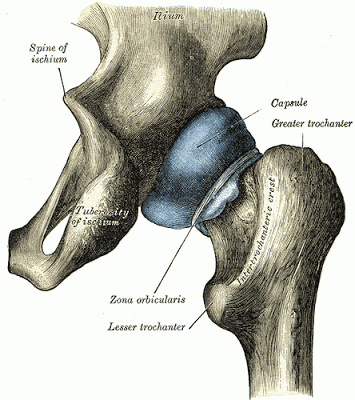by Nina
Most of us think
about our “hips” as the entire pelvic area—front, back, and sides. For example,
when we take our hip measurements to determine our pants size, we put the tape
measure all around the widest part of pelvis. But when medical professionals talk
about hip problems or breaking a hip, they are typically referring to the hip
joint itself, where your pelvis connects to your thighbone. Here is an
illustration:

Like your shoulder joint (see All About Your Shoulders), your hip joint allows a large
range of motion. It is a joint is a synovial joint, which means it connects your
pelvic bone and thighbone (femur) together with a joint capsule (a sock-like
sleeve of connective tissue that holds the two bones relatively close together).
The inner lining of this capsule is lined with synovial membrane, which secretes
a lubricating liquid that allows the bones to move over each other more
smoothly. Think about that the next time you’re moving in and out of a yoga standing
pose or even just walking down the street. (For more on the anatomy of the hip
joint, see Arthritis of the Hip Joint.) Here’s
a list of all the movements you can make from your hip joints!
1. Flexion: This
means moving your leg in toward the front of your lower torso or bringing the
front of your lower torso toward your leg (a forward bend in your hips). For
example, lifting your leg up in Standing Hand to Foot pose (Hasta
Padangustasana) or Reclined Standing Hand to Foot pose (Supta Padangusthasana),
stepping one leg forward and bending that knee as in Warrior 1 (Virabrdrasana
1) or tipping the hips forward over the leg Pyramid pose
(Pasvottanasana).
2. Extension: This means moving your
leg back toward the back of your lower torso or bringing the back of your lower
torso toward your leg (a backbend in your hips). For example, when you step
your back leg back into Warrior 1 or lift your legs up in Locust pose
(Salabasana).
3. Abduction: This means moving your
leg to the side, away from the midline of your body. For example, when you step
both legs out to the sides from Mountain pose (Tadasana) into the wide-leg
stance for a standing pose such as Triangle pose (Trikonasana).
4. Adduction: This
means moving one leg across the other, as in Eagle pose (Garudasana), or moving
a leg that was out to the side back toward the midline of the body, such as
stepping back into Mountain pose from a wide-leg stance.
5. External
Rotation: This means turning your leg out within your hip socket so
the leg turns away from the midline of your body. For example, when setting up
your front foot position for Triangle pose, you externally rotate your front
leg as you turn your front foot out to 90 degrees before entering the full pose.
This movement is almost always combined with one or more of the others listed
above.
6. Internal
Rotation: This means turning your leg in within your hip socket so the
leg turns toward the midline of your body. For example, when you are setting up
your back foot position for Triangle pose, you internally rotate your back leg
as your turn your back foot slightly inward. This movement is almost always
combined with one or more of the others listed above.
As with the shoulder joint, the hip joint structure that
provides so much range of motion also creates certain vulnerabilities. For
example, arthritis of the hip joint is a particularly common in those who are
aging. So, keeping your hips happy and healthy should be a regular component of
your yoga for healthy aging practice. Generally, this means practicing both
stretching and strengthening the muscles around the hip joint, unless you are someone who is hypermobile, in
which case, you should focus just on strengthening.
Here’s the information we have on the blog that help you
figure out how to practice whether your hip joints are currently healthy or you
are having a problem with them.
Anatomy
In Differences Between Male and Female Pelvic Structures
Shari discusses the differences between the male and female pelvic structure
and how that might influence the way that you practice to keep your hip joints
happy and healthy.
In The Psoas Muscle and Yoga
Baxter discusses the psoas muscle, a really important muscle that affects your
hip joints, as it connects your spine with your leg through your hip.
Preventing Problems
In Keeping Your Hips Happy and Healthy
by Shari provides general advice for practicing to keep your hip joints in
healthy condition.
In Featured Sequence: New Lower Body Strength Sequence
Baxter provides an all-around sequence that will strengthen the muscles around
the hip joint.
In Friday Q&A: Strengthening Your Hips
Baxter provides a sequence for strengthening muscles around the hip joints
designed especially for someone who is hypermobile in those joints.
In Featured Sequence: Lower Body Flexibility Practice
Baxter provides an all-around sequence that will allow you to move your hip
joints through their entire range of motion.
In Interview with Charlotte Bell, Author of Hip-Healthy Asana
I interview Charlotte about her reasons for writing this book and her basic advice.
In Excerpts from Hip-Healthy Asana
we share some excerpts from Charlotte Bell’s book, including a sequence!
In Friday Q&A: Opening Your Hips Without Knee Pain Baxter provides a short sequence for moving the hip joints in their entire range of motion for those who have problematic knees.
In Too Much Yoga or Just the Wrong Kind?
I discusses the problem of hypermobility in the hip joints and provide advice changing your practice to prevent development of future problems.
Addressing Problems
In Arthritis of the Hip Joint Baxter and I describe the anatomy of the hip joint, how arthritis can develop in the joint, and how to practice to stabilize and/or improve arthritis symptoms.
In All About Hip Replacements and Yoga I provides an overview of all the information we have on the blog about hip replacements and how to practice if you have one. There’s a lot!
In Yoga and Hip Dysplasia
Baxter discusses what hip dysplasia is and how to practice if you have it.
In Friday Q&A: Hip Pain and Yoga
Shari and Baxter provide more advice for practicing with hip dysplasia when
there is pain.
In Friday Q&A: Recovering from Hip Fracture
Baxter provides advice for practicing when you are recovering from a hip joint
fracture but have not had a joint replacement.
In Friday Q&A: Yoga and Bursitis, Baxter provides information about what bursitis in the hip is and how to practice if you have it.
Follow Yoga for Healthy Aging on Facebook ° To order Yoga for Healthy Aging: A Guide to Lifelong Well-Being, go to Amazon, Shambhala, Indie Bound or your local bookstore.


Leave A Comment